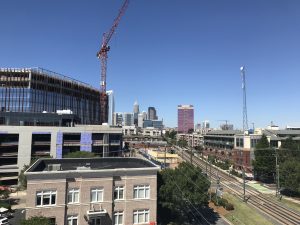Here in the Carolinas, we’re no strangers to revitalization efforts. The view from my office in our SouthEnd (Charlotte) location tells the tale.
Once an area of robust textile manufacturing, virtually abandoned when the industry left, SouthEnd is now a thriving Charlotte community. Empty textile mills and warehouses have been converted into restaurants, shops, offices, and even high-end residential construction. New construction abounds, too, but it’s the renovation of old buildings that has been most notable.
Here and elsewhere, I predict that revitalization pace will quicken thanks to changes to bonus depreciation made by the Tax Cuts and Jobs Act. (I covered this topic recently as it related to cost segregation studies, but I don’t think the impact to revitalization efforts can be ignored.)
Bonus depreciation allows for an immediate tax deduction on certain capital expenditures. At its inception, it allowed for a tax write-off of up to 30% on equipment acquired for business use. In that way, it helped companies that acquired equipment or made land improvements. But, those assets had to pass the “first use” test, meaning they had to be brand new to qualify for bonus depreciation. Now, thanks to the Tax Cuts and Jobs Act, that “first use” test has been eliminated, effectively making the purchase of used property acquired after September 27, 2017 bonus eligible up to 100% (for the next five years anyway). Further, eligible property in a real estate acquisition completed after this date is now bonus eligible, even if the property already existed at the time of acquisition.
In addition to the new bonus depreciation rules, the definition of “179 property” has been expanded to include roofs, HVAC, sprinklers systems and Qualified Improvement Property when those items are installed after the building is originally placed in service. This means that all of these assets are eligible for immediate write-off when installed. This deduction is limited to $1 million per year and starts phasing out once $2.5 million in eligible property is acquired.
If you’re in the business of purchasing and revitalizing properties, now is the best chance you’ve ever had to realize some significant tax breaks.
Consider the following example on a $5M property (this is just an example; your property may yield very different results):
- A cost segregation study (which broke out the parking lot, landscaping, and process equipment associated with the property) reveals 15% of the acquisition cost, or $750,000, is bonus eligible in 2018. 100% of that is tax deductible, making the property immediately more valuable.
- A subsequent $1.5M investment in renovation yields $1.2M in write-offs: $1M in “179 property expense” for investments in roofing and HVAC ($750,000 and $250,000 respectively), and 100% write-off under new bonus rules for $500,000 invested in carpet, drywall, lighting, plumbing, and furniture, all of which can be categorized as capital assets.
Again, your numbers may vary, but the potential tax savings are staggering. In the above example, the taxpayer invested $5M in the property, $1.5M in renovations, and yielded $1.95M in immediate deductions ($750,000 on the acquisition purchase and $1.2 million on the renovation). That’s serious tax savings!
If you’re in the business of buying and renovating properties, showing such properties, or manufacturing products that would go into an upfit, buckle up. It’s more advantageous than ever to purchase and rehabilitate old facilities. Give us a call for help and advice on your specific situation.
